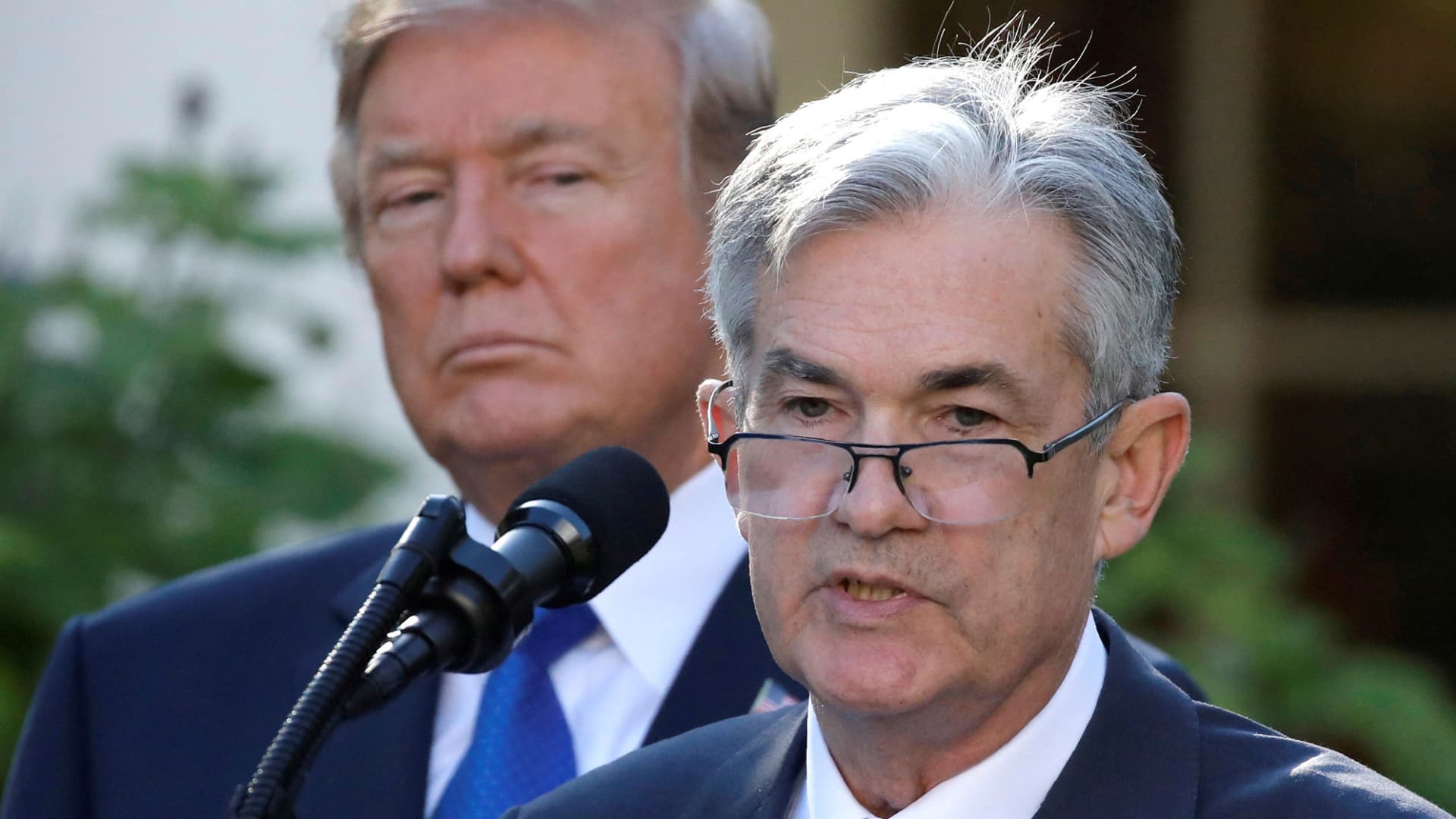The economy still isn’t behaving the way anyone expected.
Personal Finance
High inflation to delay rate cuts, uncertain economy
Published
1 year agoon

But inflation, after easing remarkably in 2023, has stayed unexpectedly hot since the start of the year. And that’s confounding economists and Federal Reserve officials who are still struggling to understand the post-pandemic world.
Higher borrowing costs were widely expected to tackle inflation with full force, to bring the roaring economy crashing down — or both. Instead, things seem to be settling in a confusing spot, with price increases still above normal, but other parts of the economy holding strong, too. The result is more uncertainty for experts, consumers and businesses alike about what might happen next in an economy that is still resisting the usual rules.
“We got through some of that ‘transitory’ part,” said Diane Swonk, chief economist at KPMG, referring to more temporary sources of inflation that drove price increases in 2021 and 2022, such as supply chain problems and energy prices. “We haven’t gotten to the fundamental part — and the hard part.”
When the year started, it appeared the Fed and White House had pulled off the unthinkable: no recession, easing inflation and a still-booming job market. That momentum led Fed leaders in December to pencil in three interest rate cuts this year, projections they repeated last month.
But then January and February price data came in unexpectedly high. For a while, policymakers hoped those were bumps in the road, not a more worrisome trend. But March data, released this week by the Bureau of Labor Statistics, cemented any lingering doubts.
Officials have long said they need a bit more assurance that inflation is trending down before they can cut rates. But after March’s disappointing report, central bankers might be losing the confidence they already had. So long as other strengths like the job market hold up, the Fed won’t have a compelling reason to cut rates and take pressure off the economy while inflation keeps festering.
As a result, financial markets and Fed watchers are no longer banking on June for an initial rate cut. The farther the timeline gets pushed back — possibly to Fed meetings in July, September or November — the closer the central bank bumps up against the presidential election, despite concerted attempts to avoid politics at all costs. On the flip side, the longer the Fed leaves rates high, the more it risks softening a generally strong economy just as President Biden and former president Donald Trump duel over who can best manage it.
“The Fed doesn’t want to be influenced by the political calendar,” said Eswar Prasad, an economist at Cornell University and a senior fellow at the Brookings Institution. “The closer we get to November for that interest rate pivot, the more uncomfortable that is going to be.”
Part of the reason officials would otherwise want to cut rates is because too much pressure on the economy can cause other problems, even if inflation ebbs. Rates that stay high for a long time can eventually wear on the job market, persuading employers to stop adding jobs or lay off the staff they already have.
That leaves the Fed to balance its precarious inflation fight against daunting risks. The central bank is charged with keeping inflation in check and maximizing employment at the same time, even though those goals can conflict.
“If we ease too much or too soon, we could see inflation come back,” Fed Chair Jerome H. Powell said at a news conference last month. “And if we ease too late, we could do unnecessary harm to employment and people’s working lives.”
When the Fed raced to hoist interest rates two years ago, the underlying picture was different. Broken supply chains sent prices up for all kinds of goods as people rushed to buy used cars, at-home office equipment and backyard furniture. A jolt of government stimulus also injected fresh demand into the economy, sending checks into peoples’ pockets as they filled restaurants, concert venues and hotels that were hobbling back from the pandemic.
The Fed was late to respond. To catch up, officials doled out whopping interest rate hikes to get borrowing costs high enough to slow the economy. The overwhelming expectation was that those moves would cause a recession. Powell warned of pain ahead.
Not only did the Fed avoid a downturn, but inflation came down significantly, too: After peaking at an annual rate of 7.1 percent in mid-2022, the Fed’s preferred inflation gauge clocked in at 2.5 percent in February. (Another inflation measure released this week peaked at 9.1 percent in June 2022 and now sits at 3.5 percent.)
Yet it isn’t entirely clear how much of that progress came from interest rate hikes alone. Econ 101 teaches that high rates cool demand by making it more expensive to get a mortgage, buy a car or grow a business. But surprises came there, too. The housing market, for example, went through a brief downturn but rebounded quickly. Home prices are still inching up, and many buyers haven’t shied from mortgage rates around 6 or 7 percent.
Much of the relief on inflation came from supply chains getting back into gear. Gas and energy costs also fell dramatically, a welcome pivot after they surged following Russia’s 2022 invasion of Ukraine.
The stickiest inflation category — which includes services like housing, hospitality, leisure and health care — still hasn’t had a major breakthrough.
“We’re probably in a much better place than many of us thought we’d be, in terms of a year ago,” said Jason Furman, a former Obama administration economist now at Harvard University. “We’re in a much worse place than we were hoping three months ago.”
At his news conference last month, Powell outlined what it would take to get inflation to hit the Fed’s 2 percent target — and put the economy on a path to rate cuts. Goods prices would need to keep simmering down. Housing costs would need to fall in line. Services inflation would need to cool, too.
But he also acknowledged what’s still unknown.
“Some combination of those three things” will be necessary, Powell said, “and it may be different from the combination we had before the pandemic.”
You may like
Personal Finance
Welcome to the zoo. That’ll be $47 today — ask again tomorrow.
Published
1 hour agoon
June 16, 2025
Giant panda Bao Li chews on bamboo during his public debut at the Smithsonian’s National Zoo in Washington, U.S., January 24, 2025.
Kevin Lamarque | Reuters
How much will it cost to visit a museum, zoo or aquarium this summer? The answer, increasingly, is: It depends.
John Linehan can rattle off almost two dozen factors that Zoo New England’s dynamic pricing contractor, Digonex, uses to recommend what to charge guests.
“It’s complicated,” said Linehan, president and CEO of the operator of the two zoos in eastern Massachusetts.
Before adopting dynamic pricing, the organization was changing prices seasonally and increasing entry rates little by little. “As we watched that pattern, we were afraid some families were going to get priced out,” he said of the earlier approach. “I’m a father of four and I know what it is like.”
Now, Zoo New England’s system provides cheaper rates for tickets purchased far in advance. That, coupled with the zoo’s participation in the Mass Cultural Council’s discounted admissions program for low-income and working families, “puts some control back in the consumer’s hands,” Linehan said.
We charge what we need to make ends meet while delivering on our mission.
John Linehan
CEO of Zoo New England
The zoo is one of many attractions embracing pricing systems that were earlier pioneered by airlines, ride-hailing apps and theme parks. While these practices allow operators to lower prices when demand is soft, they also enable the reverse, threatening to squeeze consumers who are increasingly trimming their summer travel budgets.
Before the pandemic, less than 1% of attractions surveyed by Arival, a tourism market research and events firm, used variable or dynamic pricing. Today, 17% use variable pricing, in which entry fees are adjusted based on predictable factors such as the day of the week or the season, Arival said. And 6% use dynamic pricing, in which historical and real-time data on weather, staffing, demand patterns and more influence rates.
The changes come as barely half of U.S. museums, zoos, science centers and similar institutions have fully recovered to their pre-Covid attendance levels, according to the American Alliance of Museums. That has led many to pursue novel ways of filling budget gaps and offsetting cost increases.
“There’s a saying: ‘No margin, no mission,'” Linehan said, “and we charge what we need to make ends meet while delivering on our mission.”
Entry costs are climbing even at attractions that aren’t using price-setting technology. The broad “admissions” category in the federal government’s Consumer Price Index, which includes museum fees alongside sports and concert tickets, climbed 3.9% in May from the year before, well above the annual 2.4% inflation rate.
In 2024, the nonprofit Monterey Bay Aquarium raised adult ticket prices from $59.95 to $65 and recently upped its individual membership rate, which includes year-round admission, from $95 to $125. “Gate admission from ticket sales funds the core operation of the aquarium,” a spokesperson said.
While the Denver Art Museum has no plans to test dynamic pricing, it raised admissions fees last fall, three years after a $175 million renovation and a survey of ticket prices elsewhere, a spokesperson said. Entry costs went from $18 to $22 for Colorado residents and from $22 to $27 for out-of-state visitors. Prices rise on weekends and during busy times, to $25 and $30 for in- and out-of-state visitors, respectively. Guests under age 19 always get in free thanks to a sponsored program.
Some attractions are doing a daily analysis of their bookings over the next several days or weeks and making adjustments.
Douglas Quinby
CEO of Arival
Like many attractions, the art museum posts these prices on its website. But many attractions’ publicly listed ticket prices are liable to fluctuate. The Seattle Aquarium — which raised its price ranges last summer by about $10 ahead of the opening of a new ocean pavilion — also uses Digonex’s algorithmic recommendations.
During the week of June 8, for example, the aquarium’s online visit planner, which displays the relative ticket availability for each day, offered out-of-state adult admissions as low as $37.95 for dates later in the month and as much as $46.95 for walk-in tickets that week. In addition to booking in advance, there are more than half a dozen other discounts available to certain guests, including seniors and tribal and military members, a spokesperson noted.
At many attractions, however, admission fees aren’t even provided until a guest enters the specific day and time they want to visit — making it difficult to know that lower prices may be available at another time.
“Some attractions are doing a daily analysis of their bookings over the next several days or weeks and making adjustments” to prices continuously, said Arival CEO Douglas Quinby. Prices might rise quietly on a day when slots are filling up and dip when tickets don’t seem to be moving, he said.
Digonex, which says it provides automated dynamic pricing services to more than 70 attractions worldwide, offers recommendations as frequently as daily. It’s up to clients to decide how and whether to implement them, a spokesperson said. Each algorithm is tailored to organizations’ goals and can account for everything from weather to capacity constraints and even Google Analytics search patterns.
Data-driven pricing can be “a financial win for both the public and the museum,” said Elizabeth Merritt, vice president of strategic foresight at the American Alliance of Museums. It can reduce overcrowding, she said, while steering budget-minded guests toward dates that are both cheaper and less busy.
The stegosaurus fossil nicknamed Apex is unveiled to the media at the American Museum of Natural History in New York, December 5, 2024. Billionaire Kenneth C. Griffin, who bought the stegosaurus fossil for $44.6 million, is loaning it to the museum for four years.
Timothy A. Clary | Afp | Getty Images
But steeper prices during peak periods and for short-notice visits could rankle guests — who may see anything less than a top-notch experience as a rip-off, said Stephen Pratt, a professor at the University of Central Florida’s Rosen College of Hospitality Management who studies tourism.
“Because of the higher prices, you want an experience that’s really great,” he said, transforming a low-key day at the zoo into a big-ticket, high-stakes outing. “You’ve invested this money into family time, into creating memories, and you don’t want any service mishaps.”
That could raise the risk of blowback at many attractions, especially those grappling with Trump administration cuts this summer. Some historic sites and national parks have already warned that their operations are under pressure.
Consumers should expect more price complexity to come. Arival said 16% of attractions ranked implementing dynamic pricing as a top priority for 2025-26. Among large attractions serving at least half a million guests annually, 37% are prioritizing dynamic pricing, up from the 12% that use it currently.
For visitors, that could mean hunting harder for cheaper tickets. While many museums are free year-round, others provide lower rates for off-season visits and those booked in advance. It’s also common to reduce or waive fees on certain days or hours, and many kids and seniors can often get discounted entry.
Here are a few other ways to keep admissions costs low:
Ways to save on museum tickets:
- Ask your local library. Many have museum passes that cardholders can check out.
- Bundling programs such as CityPass, GetOutPass, Go City and others allow visitors to save money on admissions to a range of attractions.
- Bank of America’s Museums on Us program offers cardholders free entry to many institutions during the first full weekend of each month.
- For the past decade, Museums for All has been providing free or reduced entry at more 1,400 U.S. museums and attractions to anyone receiving SNAP food assistance benefits.
- And each summer, the Blue Star Museums program offers museum discounts to actively serving military personnel and their families.
“It may take a bit of research,” said Quinby, “but it’s still possible to find a good deal.”

U.S. President Donald Trump looks on as Fed Chair Jerome Powell speaks at the White House in Washington on Nov. 2, 2017.
Carlos Barria | Reuters
Political pressure is mounting against the Federal Reserve Chair Jerome Powell, and yet the Federal Reserve is expected to hold interest rates steady at the end of its two-day meeting this week.
Despite a wave of recent attacks on Powell from President Donald Trump, futures market pricing is implying virtually no chance of an interest rate cut, according to the CME Group’s FedWatch gauge.
The president has argued that maintaining a fed funds rate that is too high makes it harder for businesses and consumers to borrow, adding more strain to the U.S. economy. The federal funds rate sets what banks charge each other for overnight lending, but also affects many of the borrowing and savings rates most Americans see every day.
More from Personal Finance:
Here’s the inflation breakdown for May 2025
What’s happening with unemployed Americans — in five charts
The economic cost of Trump, Harvard battle over student visas
With a rate cut likely postponed until at least September, consumers struggling under the weight of high prices and high borrowing costs aren’t getting much relief, experts say.
“The combination of high interest rates, stubborn inflation and economic uncertainty is a pretty challenging one,” said Matt Schulz, chief credit analyst at LendingTree. “Most Americans don’t have a ton of wiggle room and today they have even less.”
From credit cards and mortgage rates to auto loans and savings accounts, here’s a look at how the Fed plays a role in your finances.
Credit cards
Credit card debt continues to be a pain point for consumers struggling to keep up with high prices. Since most credit cards have a variable rate, there’s a direct connection to the Fed’s benchmark.
But even with the Fed on the sidelines, credit card rates have edged higher. The average annual percentage rate is currently just over 20%, according to Bankrate, not far from last year’s all-time high.
“This is a sign of banks trying to protect themselves from the risk that is out there in these uncertain times,” Schulz said. However, in this case, there is something consumers can do about higher APRs.

“The truth is that people have way more power over the rates they pay than they think they do, especially if they have good credit,” Schulz said.
Rather than wait for a rate cut that may be months away, borrowers could switch now to a zero-interest balance transfer credit card or consolidate and pay off high-interest credit cards with a lower-rate personal loan, he said.
Mortgages
Since 15- and 30-year mortgages are largely tied to Treasury yields and the economy, those rates haven’t moved much — and that hasn’t helped would-be buyers.
The average rate for a 30-year, fixed-rate mortgage has stayed within the same narrow range for months and is currently near 6.9%, according to Bankrate. Tack on the nationwide problem of limited inventory and housing affordability remains a key issue, regardless of the Fed’s next move.
“I don’t see any major changes coming in the immediate future, meaning that those shopping for a home this summer should expect rates to remain relatively high,” Schulz said.
Auto loans
Auto loan rates are fixed, and not directly tied to the Fed. But payments are getting bigger because car prices are rising, in part due to impacts from Trump’s trade policy.
Currently, the average rate on a five-year new car loan is 7.24%, according to Bankrate.
The growth in median car payments is outpacing both new and used car prices, according to separate data from Bank of America. Now, of those households with a monthly car payment, 20% pay more than $1,000 a month.
“Combine that with the potential for tariffs to drive auto prices even higher, and it adds up to a really challenging time to buy a car,” Schulz said. “However, shopping for the best rate and getting approved for financing before you ever set foot in the dealership can bring significant savings,” he added.
Student loans
Federal student loan rates are set once a year, based in part on the last 10-year Treasury note auction in May and fixed for the life of the loan, so most borrowers are somewhat shielded from Fed moves and recent economic turmoil.
Current interest rates on undergraduate federal student loans made through June 30 are at 6.53%. Starting July 1, the interest rates will be 6.39%.
Although borrowers with existing federal student debt balances won’t see their rates change, many are now facing other headwinds and fewer federal loan forgiveness options.
Savings
On the upside, top-yielding online savings accounts still offer above-average returns and currently pay more than 4%, according to Bankrate.
While the central bank has no direct influence on deposit rates, the yields tend to be correlated to changes in the target federal funds rate — so holding that rate unchanged has kept savings rates elevated, for now.
“The thing that is lost in this, is that savers, including millions of retirees, are actually earning good income on their savings, provided they have their money parked in a competitive place,” said Greg McBride, Bankrate’s chief financial analyst.
Personal Finance
How to protect financial assets amid immigration raids, deportations
Published
7 hours agoon
June 16, 2025
Immigration and Customs Enforcement agents detain a man after conducting a raid at the Cedar Run apartment complex in Denver, Colorado, U.S., Feb. 5, 2025.
Kevin Mohatt | Reuters
A spate of federal immigration enforcement raids from Los Angeles to New York has sparked demonstrations and rallies around the country, leading to mass arrests and National Guard deployment.
The U.S. Immigration and Customs Enforcement crackdown has heightened concerns of foreign-born residents, especially undocumented immigrants and their families, about how they should prepare for worst-case scenarios of being detained or deported.
Planning ahead for such emergency scenarios must include a strategy for who will handle their finances and how, experts say.
“When people are detained or deported without having legally designated somebody to manage their assets, they might lose access to their accounts or their property,” said Sarah Pacilio, a director at the Appleseed Network, a nonprofit network of justice centers in the U.S. and Mexico.
Managing financial matters from abroad can be challenging due to limited access to bank accounts or service providers, she said.
More from Your Money:
Here’s a look at more stories on how to manage, grow and protect your money for the years ahead.
Make a plan for a worst-case scenario
Having a plan is crucial. The Appleseed Network has published a detailed “Deportation Preparation Manual for Immigrant Families,” which is available for free on its website. There are also financial planners who offer their services for free to families in need, through groups including the Financial Planning Association and the Foundation for Financial Planning.
“Right now, there’s a lot of fear, there’s a lot of trauma,” said certified financial planner Louis Barajas, CEO of International Private Wealth Advisors.
“I want to give people information so they can at least take some power back,” said Barajas, whose firm is based in Orange County, California, and who does pro bono work with Santa Ana’s predominantly Latino community.
To protect assets — including homes, bank accounts and retirement savings — financial and legal experts recommend taking these key steps:
Collect and secure key documents
Collect and make copies of important documents, including birth certificates, immigration paperwork, other forms of identification and work permits.
Make a list of bank and credit card accounts, loans, leases, contracts, property and any assets in your children’s names. Include contact information for the banks, lenders and other companies involved with those accounts.

Store these records and documents in a safe deposit box at a bank or a fireproof, waterproof box or safe. Digitize the documents, too, with password-protected cloud storage or encrypted flash drives.
Taking this step can help ensure you have key details about accounts and assets wherever you are, and that physical documents are in one safe location for a trusted family member to access.
Check access to accounts
Contact your financial service providers to understand your options and rights. Pacilio recommends reaching out to your banks and lenders to determine if you can list a foreign address on your account, add someone to your account or continue using those accounts outside the U.S.
“Know what those options are in advance so that you can adequately prepare for them, and that helps to avoid surprise in a crisis situation,” she said.
Establish a power of attorney
Have legal documents in place, especially a financial power of attorney, or POA. Designating a POA also creates a back-up plan, Barajas said, so that “someone they trust can manage their finances if they are out of the country.”
A POA can also give the person you designate the authority to sign checks from your bank account, make decisions about your child’s schooling and health care, or use your money to buy or sell major items such as a car, according to the Appleseed Network.
Protect finances for future generations
Work with a legal expert to draft a pre-need guardianship document. Naming a guardian for your child in a legal document will allow an adult of your choice to step in if you are no longer able to care for the child, say, if you are deported and your child remains in the U.S., said Barajas, who is also a member of the CNBC Financial Advisor Council.
Consider buying a term life insurance policy, which can provide benefits to your loved ones if you die. Already have one? Carefully review your beneficiaries.

Create an estate plan. Consider setting up a trust to transfer assets such as real estate, non-retirement savings and life insurance proceeds, Barajas said.
“A lot of single mothers who have been deported do have insurance,” he said. “Because they’re they’re single mothers, they have named their minor children as beneficiaries on their life insurance policies — and that’s a major mistake.”
Insurers won’t give proceeds directly to minors, he said.
“That’s why I’d like them to get an estate plan done so they can name a trust as a beneficiary,” he said. “So if something were to happen to them, someone can manage that money for their children.”
SIGN UP: Money 101 is an 8-week learning course on financial freedom, delivered weekly to your inbox. Sign up here. It is also available in Spanish.

Senate to unveil Trump tax bill draft with SALT fight unresolved

Trump wants to make it more expensive to sue over his policies

Accounting in an era of disruption

New 2023 K-1 instructions stir the CAMT pot for partnerships and corporations

The Essential Practice of Bank and Credit Card Statement Reconciliation

Are American progressives making themselves sad?
Trending
-

 Economics1 week ago
Economics1 week agoDonald Trump has many ways to hurt Elon Musk
-

 Economics1 week ago
Economics1 week agoSending the National Guard to LA is not about stopping rioting
-

 Economics1 week ago
Economics1 week agoDonald Trump has many ways to hurt Elon Musk
-

 Blog Post1 week ago
Blog Post1 week agoMastering Bookkeeping Tasks During Peak Business Seasons
-

 Personal Finance1 week ago
Personal Finance1 week agoWhat Pell Grant changes in Trump budget, House tax bill mean for students
-

 Accounting7 days ago
Accounting7 days agoInstead adds AI-driven tax reports
-

 Personal Finance6 days ago
Personal Finance6 days agoHow markets performed for investors so far
-

 Personal Finance6 days ago
Personal Finance6 days agoTrump’s ‘big beautiful’ bill may curb access to low-income tax credit
